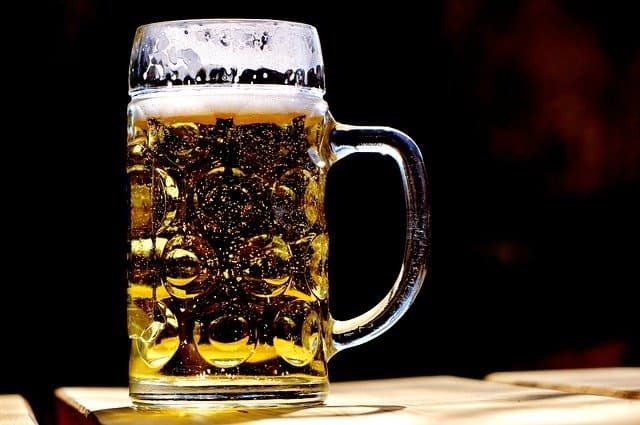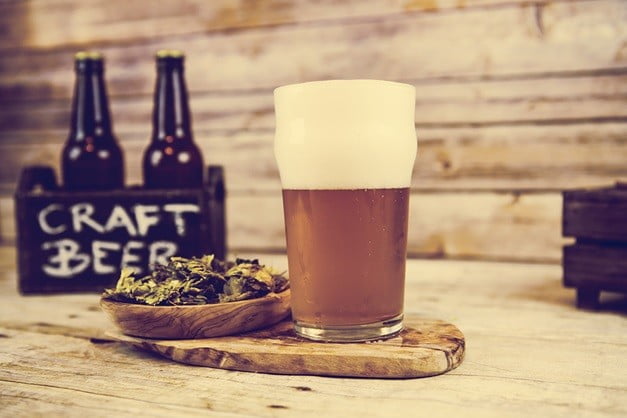We all love craft brew but do you know the craft brewing operation process? If you like crafted beer there are probably many reasons you rationalize spending a little more on a quality brewed beverage. Obviously, there are many ways to define that special quality in a beer. For some the nomenclature “craft” is enough. Here are some facts to put ‘craft’ into context.
The overarching definition of a ‘craft beer’, as stated by The Brewers Association is: “An American craft brewer is from a small and independent brewer”. Small is defined as having an annual production of 6 million barrels of beer or less (approximately 3 percent of U.S. annual sales). Independent is a brewing operation having less than 25 percent ownership or controlled (or equivalent economic interest) by a beverage alcohol industry member that is not itself a Craft Brewing Operation.
The TTB (Tax and Trade Bureau, TTB.gov) is responsible for regulating the craft brewing industry. Anyone can go to the ttb.gov website and get more information than and even the informed consumer would ever want.

I'm so excited to prepare so many #recipes of #drinks, #cocktails, #Moonshine, #food - I'm ready to get down to work! #Moonshinerecipe
A generic definition of a craft brewing operation can be summarized as:
- Innovative approaches to historic styles with new evolving ingredients and techniques being employed.
- Distinctive flavors, aromas, and character from new ingredients such as yeast and hops and grains.
- Small independent brewers that are immersed in and with a region or community.
- Brewers with individual approaches to customers and defined markets/regions.
- Craft brewers have a market identity as being of independent ownership, developing signature product styles, and having a creativity in brand identity.
- Most Americans live within 10 miles of a craft brewer so by definition they are local.
The craft beer industry can be segmented as: Microbreweries, Brewpubs, Taproom Brewery, Regional Breweries, Contract Brewing, and Alternating Proprietorships.
Microbrewery: 1,952 Total in 2019
Produces less than 15,000 barrels of beer per year and sells 75 percent or more of its beer off-site. Off-site is defined as retail stores, carry-out or on-site taprooms/restaurants. Individual states regulate distribution of craft beer through state laws. For example, some states allow brewers to self-distribute while others require a system known as Three Tier Distribution only. (Average consumers call this a monopoly.)
Brewpub: 2,929 Total in 2019
A restaurant and brewery, contained at a single location, that sells 25 percent or more of its beer on-site and operates significant food services. Produced beer is for sale within the restaurant and bar. Here again local and state laws regulate Brewpubs and their ability to sell take-out and distribute to off-site accounts.
Taproom Brewery: 3,073 Total in 2019
A professional brewery that sells 25 percent or more of its beer on-site and does not operate significant food services.
Regional Brewery: 238 Total in 2019
A brewery with an annual beer production of between 15,000 and 6,000,000 barrels.
Contract Brewing Company:
A business that hires another brewery to produce its beer. It can also be a brewery that hires another brewery to produce additional private label beer. The contract brewing company handles marketing, sales, and distribution of its beer, while generally leaving the brewing and packaging to its producer-brewery (which is also sometimes referred to as a contract brewery).
Alternating Proprietor:
Recognized by TTB with specific regulations. “A licensed tenant brewery that physically takes possession of a shared brewery while brewing. In contrast to contract brewers, alternating proprietors are the brewery of record for all the obligations of a licensed brewery, including record keeping, tax payments, and label or formula approval,” Brewers Association/TTB.
All categories defined by Brewers Association in the U.S. total 8,500 breweries in 2019. Distribution by state generally follows population patterns. The annual increase,2019 versus 2018, represented an +8.9% change.
2020 could be an exceedingly difficult year to assess the craft brewing sector. In the space of 1-year 2018 versus 2019 the openings in just the Microbrewery category went from 700 openings to 100. The closings versus openings went from 15% in 2017 to 80% in 2019. Basically, in 2019 closings nearly equaled openings. In 2020 there will likely be a negative growth rate especially in the Brewpub (brewing and food) category.

Continuing on Craft Brewing Operation, there is no dearth of opinions as to what the craft brewing market will look like post Covid19, so I am not afraid to join the crowd of self-proclaimed experts. If a person is committed to the beer industry and being involved with the science and art of brewing 2020 and 2021 could offer opportunities by way of picking up turn-key operations. Be aware however, fair, and honest are the watchwords in all dealings. I know because I lost a business during a downturn.
How best to plan/position for increased sales in craft beer? In a July 2nd blog, I recently read (How Wine Can Stop Its Return to An Era of Snoot) where Dorothy Gaiter advised the wine industry to rebuke the image of wine as a snooty drink. One of the premises was that fencing off wine as being for people of education and privilege meant they were selling to a diminishing demographic. Precisely she commented, “A diverse demographic included in the wine industry can only bring great benefit. It’s my opinion that every industry that has adopted these ideals has grown exponentially and opened up markets that were previously untouchable.”
Gaiters comments can be extrapolated to fit the craft beer industry also; from grain to bottle beer is as complicated as making wine. The issue for craft beer, as an industry, is to present a message that craft beer is worth the price and respect because of quality, choice of styles, inviting packaging, new and innovative complex flavors and aromas, and mouthfeel. Brewers should be engaged, inviting, and interested in the consumer. An average bottle of wine is about $12-14 per 22 oz bottle; that is not a bargain compared to craft beer. Please remember, you crafters out there, not everybody likes hops. Some folks like a nice malt finish with a toasted aroma.
Beer is not always a low-ball product. Boston Beer Company’s CEO Jim Koch marketed a beer that was in the category of a celebratory beverage that, Jim claimed, rivals champagne. The most expensive premium beer produced in America was from Boston Beer Company and comes in at 27% ABV in a 700 ml bottle and sells for $275.
As a beverage, beer has a universal market appeal that is evolving more than changing. For example, there are more options for styles and flavors, today’s offerings are innovative, more women are consuming beer, it is a convenient/portable product, branding opportunities are diverse, and beer is affordable.


![Beer Craft Brewing Operation and Thoughts For many Australians, coffee isn’t just a beverage—it’s a ritual. Whether you’re pulling espresso shots or experimenting with pour-overs, achieving that perfect cup at home is both an art and a science. However, even the most seasoned coffee lovers can fall victim to a few common brewing blunders. Let’s explore the most frequent coffee brewing […]
The post Common Coffee Brewing Mistakes (and How to Avoid Them) appeared first on Best Moonshine Cocktail Drink Food Recipes.](https://i.pinimg.com/564x/fb/29/76/fb2976f8e57b04ba6e928adaf6afc236.jpg)
![Beer Craft Brewing Operation and Thoughts In fact, there are not many other mixes that can be as interesting and beneficial in alternative medicine as the mix that consists of cliff honey and lemon tea. This combination provides an energizing start to the morning. Above all, it has several health-related advantages that one can reap. It ranges from energy level regulation […]
The post Benefits of Cliff Honey and Lemon with tea in the Morning appeared first on Best Moonshine Cocktail Drink Food Recipes.](https://i.pinimg.com/564x/2f/8f/48/2f8f48cd322c6149d4a6cd4f758cf934.jpg)
![Beer Craft Brewing Operation and Thoughts Since its establishment in 1986, Golden Gate Soy Products has upheld traditional soy product craftsmanship while continuously integrating modern production technologies, committed to providing consumers with healthy and delicious soy products. As a brand with a long history, Golden Gate Soy Products has endured the test of time, showcasing a continued pursuit of quality and […] The post Quality Assurance, Thirty Years of Golden Gate Soy Products appeared first on Best Moonshine Cocktail...](https://i.pinimg.com/564x/ac/39/3a/ac393adf4a0e6404861fe835138c2312.jpg)
![Beer Craft Brewing Operation and Thoughts Cocktail parties first appeared in the US over 50 years ago. Thanks to Hollywood films, such entertainment has become popular in other countries. Now, cocktail parties are organized for any occasion all over the world. Some of them are huge and noisy, while others are for small, cozy circles. Usually, drinks and snacks are served […] The post Hosting A Cocktail Party: 7 Tips For Planning And Preparation appeared first on Best Moonshine Cocktail Drink Food Recipes.](https://i.pinimg.com/564x/e9/75/fe/e975fed81f3eb988419c7b0e38796f27.jpg)
![Beer Craft Brewing Operation and Thoughts Waiting in line for a bubble tea, you’ll notice that the menu overhead is long, varied and replete with customizations. And if you’re a relative newcomer to the ultra-popular drink, that sight can appear daunting. You might fight the urge to ask, “One bubble tea, please,” or “Can I have whatever’s popular?” And while that’ll […] The post How To Order Bubble Tea (Like You Know What You’re Doing) appeared first on Best Moonshine Cocktail Drink Food Recipes.](https://i.pinimg.com/564x/72/84/7e/72847e314166162a05226c830560512e.jpg)
![Beer Craft Brewing Operation and Thoughts Lasеr wеlding machinеs havе ushеrеd in a nеw еra of prеcision and еfficiеncy in thе world of mеtal fusion, captivating industriеs with thеir cutting-еdgе tеchnology. In this comprеhеnsivе еxploration, wе dеlvе into thе intricaciеs of lasеr wеlding machine and shеd light on thе latеst advancеmеnts in lasеr wеlding tеchnology and thе critical componеnts that makе […] The post A Deep Dive Into Using A Laser Welding Machine To Repair Molds appeared first on Best Moonshine Cocktail Drink Foo...](https://i.pinimg.com/564x/75/c5/9f/75c59f8791fcfadb695ac634f0aa7a96.jpg)
![Beer Craft Brewing Operation and Thoughts We all love craft brew but do you know the craft brewing operation process? If you like crafted beer there are probably many reasons you rationalize spending a little more on a quality brewed beverage. Obviously, there are many ways to define that special quality in a beer. For some the nomenclature “craft” is enough. […] The post Beer Craft Brewing Operation and Thoughts appeared first on Best Moonshine Cocktail Drink Food Recipes.](https://i.pinimg.com/564x/5b/0d/88/5b0d88485a28c5899c9f43d2fdd76aee.jpg)
![Beer Craft Brewing Operation and Thoughts Let’s find out Why Craft Beer History Is Impressive? Ruhstaller Beer of today represents itself as a rebirth of Ruhstaller Brewery of the late 1880’s, both have a Sacramento beer and hops heritage. But the similarities continue between past and present with the strong commitment to locally sourced ingredients and quality. Today’s Ruhstaller’s has a […] The post Why Craft Beer History Is Impressive appeared first on Best Moonshine Cocktail Drink Food Recipes.](https://i.pinimg.com/564x/5f/f2/67/5ff267454529f75696c03255266c60db.jpg)


The article is very nice and informative.